Related Research Articles

William Morris was a British textile designer, poet, artist, writer, and socialist activist associated with the British Arts and Crafts movement. He was a major contributor to the revival of traditional British textile arts and methods of production. His literary contributions helped to establish the modern fantasy genre, while he helped win acceptance of socialism in fin de siècle Great Britain.

The Arts and Crafts movement was an international trend in the decorative and fine arts that developed earliest and most fully in the British Isles and subsequently spread across the British Empire and to the rest of Europe and America.

Quillwork is a form of textile embellishment traditionally practiced by Indigenous peoples of North America that employs the quills of porcupines as an aesthetic element. Quills from bird feathers were also occasionally used in quillwork.
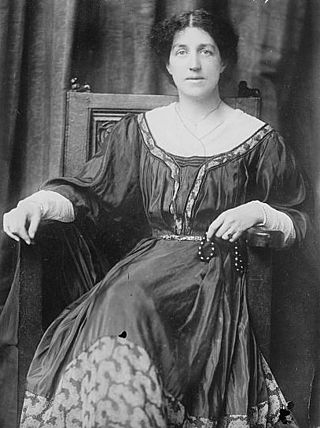
Mary "May" Morris was an English artisan, embroidery designer, jeweller, socialist, and editor. She was the younger daughter of the Pre-Raphaelite artist and designer William Morris and his wife and artists' model, Jane Morris.

Art needlework was a type of surface embroidery popular in the later nineteenth century under the influence of the Pre-Raphaelites and the Arts and Crafts Movement.

Morris, Marshall, Faulkner & Co. (1861–1875) was a furnishings and decorative arts manufacturer and retailer founded by the artist and designer William Morris with friends from the Pre-Raphaelites. With its successor Morris & Co. (1875–1940) the firm's medieval-inspired aesthetic and respect for hand-craftsmanship and traditional textile arts had a profound influence on the decoration of churches and houses into the early 20th century.

A rubric is a word or section of text that is traditionally written or printed in red ink for emphasis. The word derives from the Latin: rubrica, meaning red ochre or red chalk, and originates in medieval illuminated manuscripts from the 13th century or earlier. In these, red letters were used to highlight initial capitals, section headings and names of religious significance, a practice known as rubrication, which was a separate stage in the production of a manuscript.
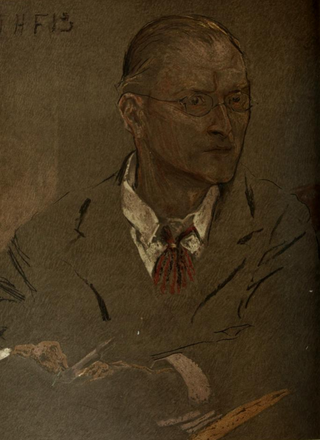
Charles Francis Annesley Voysey was an English architect and furniture and textile designer. Voysey's early work was as a designer of wallpapers, fabrics and furnishings in a Arts and Crafts style and he made important contribution to the Modern Style, and was recognized by the seminal The Studio magazine. He is renowned as the architect of several country houses.

American craft is craft work produced by independent studio artists working with traditional craft materials and processes. Examples include wood, glass, clay (ceramics), textiles, and metal (metalworking). Studio craft works tend to either serve or allude to a functional or utilitarian purpose, although they are just as often handled and exhibited in ways similar to visual art objects.

Merton Abbey Mills is a former textile factory in the parish of Merton in London, England near the site of the medieval Merton Priory, now the home of a variety of businesses, mostly retailers.
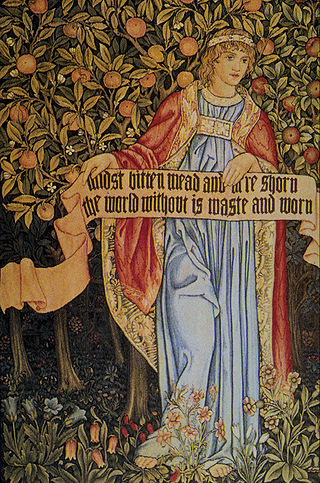
John Henry Dearle was a British textile and stained-glass designer trained by the artist and craftsman William Morris who was much influenced by the Pre-Raphaelite Brotherhood. Dearle designed many of the later wallpapers and textiles released by Morris & Co., and contributed background and foliage patterns to tapestry designs featuring figures by Edward Burne-Jones and others. Beginning in his teens as a shop assistant and then design apprentice, Dearle rose to become Morris & Co.'s chief designer by 1890, creating designs for tapestries, embroidery, wallpapers, woven and printed textiles, stained glass, and carpets. Following Morris's death in 1896, Dearle was appointed Art Director of the firm, and became its principal stained glass designer on the death of Burne-Jones in 1898.

The New Gallery is a Crown Estate-owned Grade II Listed building at 121 Regent Street, London, which originally was an art gallery from 1888 to 1910, The New Gallery Restaurant from 1910 to 1913, The New Gallery Cinema from 1913 to 1953, and a Seventh-day Adventist Church from 1953 to 1992. After having been empty for more than ten years, the building was a Habitat furniture store from 2006 to 2011, and since September 2012 it is a flagship store for Burberry.
The Arts and Crafts Exhibition Society was formed in London in 1887 to promote the exhibition of decorative arts alongside fine arts. The Society's exhibitions were held annually at the New Gallery from 1888 to 1890, and roughly every three years thereafter, were important in the flowering of the British Arts and Crafts Movement in the decades prior to World War I.

The Adoration of the Magi is a Morris & Co. tapestry depicting the story in Christianity of the Three Kings who were guided to the birthplace of Jesus by the star of Bethlehem. It is sometimes called The Star of Bethlehem or simply The Adoration.

The Holy Grail or San Graal tapestries are a set of six tapestries depicting scenes from the legend of King Arthur and the quest for the Holy Grail. The tapestries were commissioned from Morris & Co. by William Knox D'Arcy in 1890 for his dining room at Stanmore Hall, outside London. Additional versions of the tapestries with minor variations were woven on commission by Morris & Co. over the next decade.
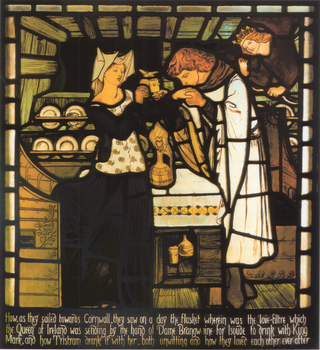
The Tristram and Isoude stained glass panels are a series of 13 small stained-glass windows made in 1862 by Morris, Marshall, Faulker & Co. for Harden Grange, the house of textile merchant Walter Dunlop, near Bingley in Yorkshire, England. Depicting the legend of Tristan and Iseult, they were designed by six of the leading Pre-Raphaelite artists of the day, to an overall design by William Morris. They were acquired in 1917 by Cartwright Hall Art Gallery, which is now part of Bradford Museums & Galleries. They can be seen on display at Cliffe Castle, Keighley.
Charles Joseph Faulkner (1833–1892) was a British mathematician and fellow of University College, Oxford and a founding partner of Morris, Marshall, Faulkner and Co. where he worked with his sisters Kate Faulkner and Lucy Faulkner Orrinsmith.
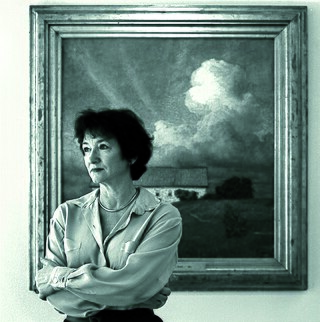
Françoise Cachin was a French art historian and curator. She was the founding director of the Musée d’Orsay and the author of numerous books on 19th-century French painting.

7 Hammersmith Terrace is an historic house in the London borough of Hammersmith and Fulham, England, and the former home of English engraver and printer Emery Walker. Walker was an important figure in the English Arts and Crafts movement, and a close friend of textile designer William Morris, who lived nearby. During his life, Walker furnished the home in an Arts and Crafts style, reflecting his friendships with Morris and others.

William Morris (1834-1898), a founder of the British Arts and Crafts movement, sought to restore the prestige and methods of hand-made crafts, including textiles, in opposition to the 19th century tendency toward factory-produced textiles. With this goal in mind, he created his own workshop and designed dozens of patterns for hand-produced woven and printed cloth, upholstery, and other textiles.
References
- ↑ Wilk, Christopher (29 January 2024). "Linda Parry obituary". The Guardian.
- ↑ Stansky, Peter (Autumn 1997). "William Morris / Art, Enterprise and Ethics: The Life and Works of William Morris / William Morris: Art and Kelmscott". Victorian Studies. 41 (1): 156–160. ProQuest 211940348.
- ↑ Abramian-Mott, Alexandria (25 August 2005). "MIXED MEDIA; The fabric of history; Textiles of the Arts & Crafts Movement Linda Parry Thames & Hudson; $24.95". Los Angeles Times. p. F.8. ProQuest 421994462.